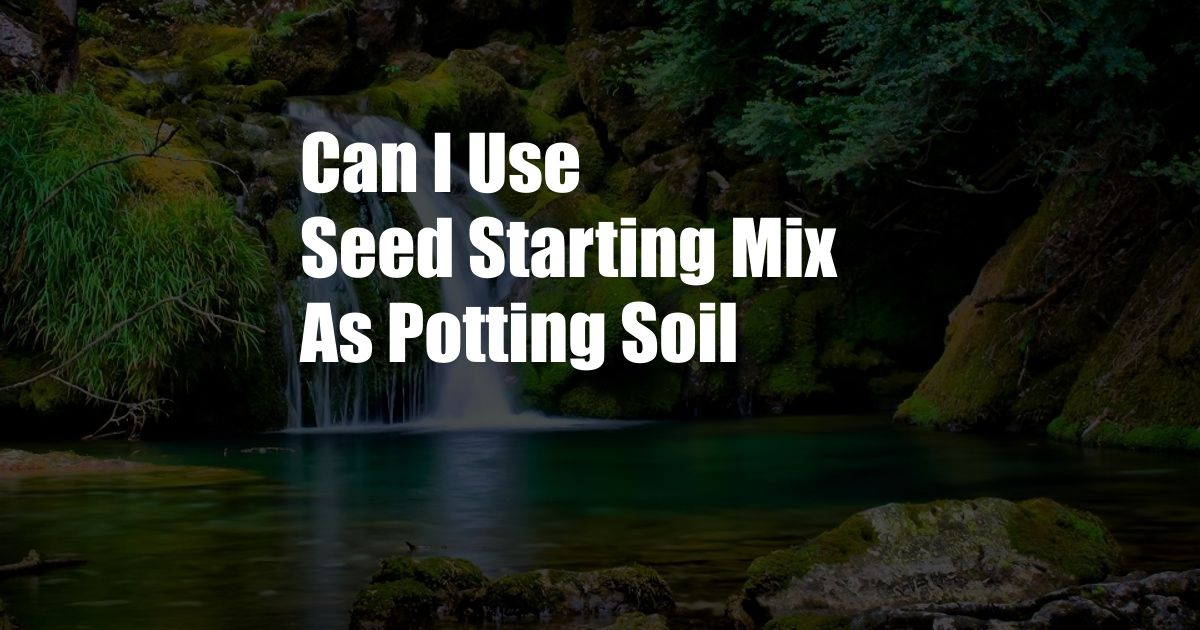
Can I Use Seed Starting Mix as Potting Soil?
In the realm of gardening, nurturing seedlings is a crucial step towards thriving plants. Often, this involves using specialized seed starting mix, a nutrient-rich medium designed to promote optimal germination and early plant growth. However, as these seedlings mature, a question arises: can I continue using the seed starting mix as potting soil?
The answer to this query lies in comprehending the distinct characteristics of seed starting mix and potting soil. Seed starting mix is typically composed of lightweight materials such as peat moss, vermiculite, and perlite, enabling quick and efficient drainage that is crucial for delicate seedlings. In contrast, potting soil is denser and includes organic matter like compost or manure, providing sustained nourishment for established plants.
Seed Starting Mix vs. Potting Soil
To further explicate the differences between seed starting mix and potting soil, let’s delve into their specific compositions:
- Seed starting mix: Formulated with a high proportion of lightweight materials like peat moss, vermiculite, and perlite, ensuring excellent drainage and aeration.
- Potting soil: Contains a blend of organic matter (e.g., compost, manure), topsoil, and inorganic materials (e.g., perlite, vermiculite), offering substantial nutrients and moisture retention.
These distinct compositions directly impact the suitability of each medium for different plant growth stages. Seed starting mix, with its optimal drainage and lower nutrient content, is ideal for the initial stages of seed germination and young seedling development. Potting soil, on the other hand, provides the necessary nutrients and moisture retention for continued plant growth and maturity.
Can You Use Seed Starting Mix as Potting Soil?
While seed starting mix may be employed as a temporary potting soil substitute, it is not a long-term solution. Seed starting mix is designed to encourage rapid seed germination and seedling growth but lacks the essential nutrients and sustained moisture retention required by mature plants. Prolonged use of seed starting mix as potting soil can result in nutrient deficiencies, stunted growth, and diminished plant health.
To ensure optimal plant development, it is highly recommended to transplant seedlings into a suitable potting soil once they have developed their first set of true leaves. Potting soil offers a more balanced nutrient profile and moisture retention capacity, catering to the evolving needs of growing plants.
Tips and Expert Advice
To enhance your gardening endeavors, consider the following tips and expert advice:
- Select the right seed starting mix: Choose a mix specifically designed for seed starting, ensuring optimal drainage and aeration.
- Avoid overwatering: Seed starting mix drains quickly, so water sparingly to prevent damping-off disease.
- Fertilize seedlings lightly: Seedlings can benefit from a diluted liquid fertilizer, but avoid overdoing it.
- Transplant seedlings promptly: Once seedlings develop true leaves, transplant them into potting soil.
- Choose the appropriate potting soil: Select a potting soil tailored to the specific plant type or group.
By following these expert recommendations, you can foster healthy plant growth and maximize the potential of your gardening efforts.
FAQs on Seed Starting Mix vs. Potting Soil
Q: Can I use seed starting mix for all plants?
A: No, seed starting mix is best suited for the early stages of plant growth. Potting soil is more appropriate for mature plants.
Q: When should I transplant seedlings to potting soil?
A: Transplant seedlings once they have developed their first set of true leaves.
Q: Can I mix seed starting mix with potting soil?
A: Yes, mixing seed starting mix with potting soil can create a balanced medium for young plants. Use a 50:50 ratio.
Q: How often should I water plants in seed starting mix?
A: Water sparingly, allowing the mix to dry out slightly between watering.
Q: How do I choose the right potting soil?
A: Consider the specific needs of your plants. Choose a potting soil with appropriate drainage, nutrient content, and pH level.
Conclusion
Understanding the differences between seed starting mix and potting soil empowers gardeners with the knowledge to make informed decisions for the well-being of their plants. Seed starting mix, though not a long-term replacement for potting soil, plays a vital role in the early stages of plant growth. By adhering to expert advice and utilizing the right medium for each growth stage, you can nurture thriving plants that bring joy and fulfillment to your gardening journey.
Are you interested in further exploring the world of seed starting and potting soil? Share your thoughts and experiences in the comments below!